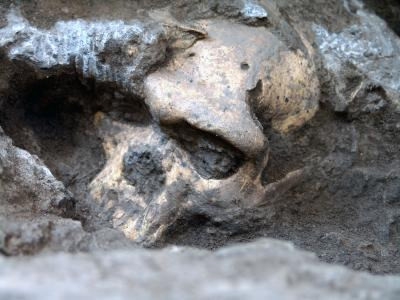1.8-Million-Year-Old Skull Suggests Human Ancestors Belonged To One Species [PHOTO]

A 1.8-million-year-old skull uncovered in the Republic of Georgia may change the story of human evolution.
The skull, known as Skull 5, was found in pieces in 2000 and 2005 among other human and animal fossils in the village of Dmanisi. The complete skull has a small braincase, long face and large teeth, combining features previously ascribed to three different species under the Homo genus. The findings, published in Science, suggest early humans belonged to one species rather than a bunch of different ones.
“Skull 5 unites some key features, like the tiny braincase and large face, which had not been observed together in an early Homo fossil until now," Christoph Zollikofer from the Anthropological Institute and Museum in Zurich, Switzerland, told the BBC.
Scientists have studied the skull for eight years, comparing Skull 5’s cranium and jaw with four other hominid skulls found at the same site and others from Africa. It's described as the “the world’s first completely preserved adult hominid skull,” but analysis from taken from African skulls dating from 2.4 million and 1.2 million years ago showed that its measurements are similar to those found in modern humans.
"Since we see a similar pattern and variation in the African fossil record ... it is sensible to assume that there was a single Homo species at that time in Africa," Zollikofer said in a statement. "And since the Dmanisi hominids are so similar to the African ones, we further assume that they both represent the same species."
Skull 5 shares several characteristics from two early species, Homo habilis and Homo erectus, but the study’s authors suggest that those along with a third early human species, Homo rudolfensis, are part of one species that stretched from Africa to Southeast Asia.
“We have, now, one global human species,” Zollikofer told the Globe and Mail. “What we can infer from our studies at Dmanisi is that 1.8 million years ago, there was another single, global species.”
But some scientists disagree.
“Seen across a parking lot, a Mercedes and a Chrysler might look pretty similar, but there’s a hell of a lot going on inside that suggest these are very different motor cars,” Bernard Wood, a paleoanthropologist at George Washington University said.
Others point to the skull’s anatomy around its front teeth as differing drastically from two different early human species, Susan Antón of New York University told USA Today.
But most scientists do find common ground in Skull 5’s brain size. About one third of the size of a modern human, the skull’s brain shows hominids “did not need a large brain or sophisticated stone tools to disperse out of Africa,” lead author David Lordkipanidze, of the Georgian National Museum in Tbilisi, said.
Chris Stringer at the Natural History Museum in London, a proponent of the study, says the team made a strong argument for all human ancestors being lumped under one lineage.
"Only H. erectus survives and becomes successful, but at the origin nature was experimenting with how to evolve humans in terms of increasing brain size," Stringer told BBC News. "Creatures were starting to use tools and eat meat, and this drove evolution, but I think it also drove diversity. The Dmanisi group is an example of the successful species that came out of that and then carried on to spread around the Old World."
© Copyright IBTimes 2025. All rights reserved.






















